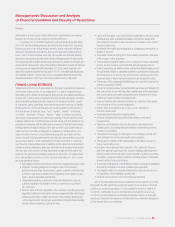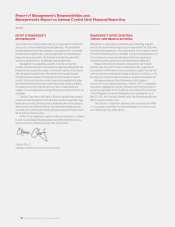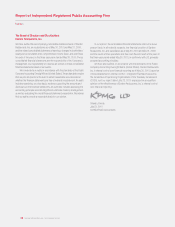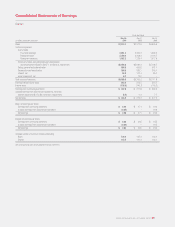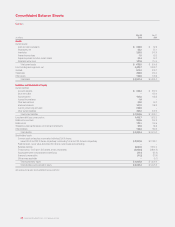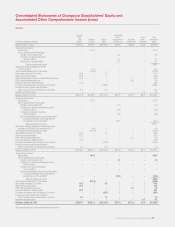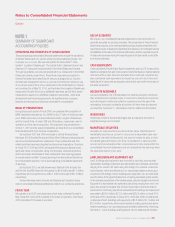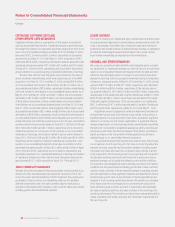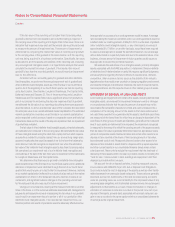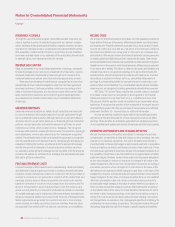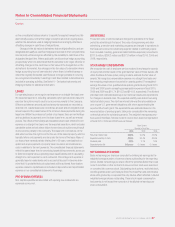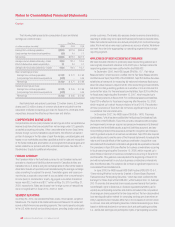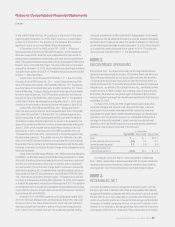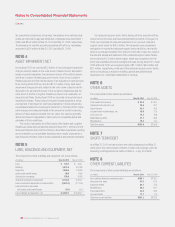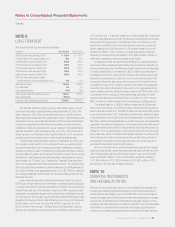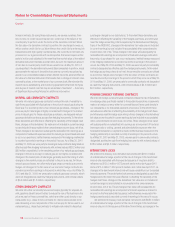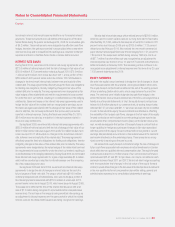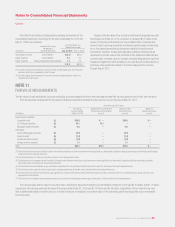Red Lobster 2010 Annual Report Download - page 47
Download and view the complete annual report
Please find page 47 of the 2010 Red Lobster annual report below. You can navigate through the pages in the report by either clicking on the pages listed below, or by using the keyword search tool below to find specific information within the annual report.
If the fair value of the reporting unit is higher than its carrying value,
goodwill is deemed not to be impaired, and no further testing is required. If
the carrying value of the reporting unit is higher than its fair value, there is an
indication that impairment may exist and the second step must be performed
to measure the amount of impairment loss. The amount of impairment is
determined by comparing the implied fair value of reporting unit goodwill
to the carrying value of the goodwill in the same manner as if the reporting
unit was being acquired in a business combination. Specifically, fair value
is allocated to all of the assets and liabilities of the reporting unit, including
any unrecognized intangible assets, in a hypothetical analysis that would
calculate the implied fair value of goodwill. If the implied fair value of
goodwill is less than the recorded goodwill, we would record an impairment
loss for the difference.
Consistent with our accounting policy for goodwill and other indefinite-
lived intangibles, we performed the annual impairment test of goodwill and
other indefinite-lived intangible assets as of the first day of our fourth fiscal
quarter. As of the beginning of our fourth fiscal quarter, we had six reporting
units: Red Lobster, Olive Garden, LongHorn Steakhouse, The Capital Grille,
Bahama Breeze and Seasons 52. Two of these reporting units, LongHorn
Steakhouse and The Capital Grille, have a significant amount of goodwill. As
part of our process for performing the step one impairment test of goodwill,
we estimated the fair value of our reporting units utilizing the income approach
described above, to derive an enterprise value of the Company. We reconciled
the enterprise value to our overall estimated market capitalization. The estimated
market capitalization considers recent trends in our market capitalization
and an expected control premium, based on comparable recent and historical
transactions. Based on the results of the step one impairment test, no impairment
of goodwill was indicated.
The fair value of other indefinite-lived intangible assets, primarily trademarks,
are estimated and compared to the carrying value. We estimate the fair value
of these intangible assets using the relief-from-royalty method, which requires
assumptionsrelatedtoprojectedsalesfromourannuallong-rangeplan;
assumedroyaltyratesthatcouldbepayableifwedidnotownthetrademarks;
and a discount rate. We recognize an impairment loss when the estimated
fair value of the indefinite-lived intangible asset is less than its carrying value.
We completed our impairment test of our indefinite-lived intangibles and
concluded as of the date of the test, there was no impairment of the trademarks
for LongHorn Steakhouse and The Capital Grille.
We determined that there was no goodwill or indefinite-lived intangible
asset impairment as of the first day of our fourth fiscal quarter and no additional
indicators of impairment were identified through the end of our fourth fiscal
quarter that would require us to test further for impairment. However, declines
in our market capitalization (reflected in our stock price) as well as in the market
capitalization of others in the restaurant industry, declines in sales at our
restaurants, and significant adverse changes in the operating environment
for the restaurant industry may result in future impairment.
Changes in circumstances, existing at the measurement date or at other
times in the future, or in the numerous estimates associated with management’s
judgments and assumptions made in assessing the fair value of our goodwill,
could result in an impairment loss of a portion or all of our goodwill or other
indefinite-lived intangible assets. If we recorded an impairment loss, our
financial position and results of operations would be adversely affected and our
leverage ratio for purposes of our credit agreement would increase. A leverage
ratio exceeding the maximum permitted under our credit agreement would be
a default under our credit agreement. At May 30, 2010, a write down of goodwill,
other indefinite-lived intangible assets, or any other assets in excess of
approximately $1.07 billion, on an after-tax basis, would have been required
to cause our leverage ratio to exceed the permitted maximum. As our leverage
ratio is determined on a quarterly basis and due to the seasonal nature of our
business, a lesser amount of impairment in future quarters could cause our
leverage ratio to exceed the permitted maximum.
We evaluate the useful lives of our intangible assets, primarily intangible
assets associated with the RARE acquisition, to determine if they are definite
or indefinite-lived. A determination on useful life requires significant judgments
and assumptions regarding the future effects of obsolescence, demand,
competition, other economic factors (such as the stability of the industry,
legislative action that results in an uncertain or changing regulatory environment,
and expected changes in distribution channels), the level of required mainte-
nance expenditures, and the expected lives of other related groups of assets.
IMPAIRMENT OR DISPOSAL OF LONG-LIVED ASSETS
Land, buildings and equipment and certain other assets, including definite-lived
intangible assets, are reviewed for impairment whenever events or changes
in circumstances indicate that the carrying amount of an asset may not be
recoverable. Recoverability of assets to be held and used is measured by a
comparison of the carrying amount of the assets to the future undiscounted
net cash flows expected to be generated by the assets. Identifiable cash flows
are measured at the lowest level for which they are largely independent of the
cash flows of other groups of assets and liabilities, generally at the restaurant
level. If such assets are determined to be impaired, the impairment recognized
is measured by the amount by which the carrying amount of the assets exceeds
their fair value. Fair value is generally determined based on appraisals or sales
prices of comparable assets. Restaurant sites and certain other assets to be
disposed of are reported at the lower of their carrying amount or fair value,
less estimated costs to sell. Restaurant sites and certain other assets to be
disposed of are included in assets held for disposal within prepaid expenses
and other current assets in our consolidated balance sheets when certain
criteria are met. These criteria include the requirement that the likelihood of
disposing of these assets within one year is probable. Assets not meeting the
“held for sale” criteria remain in land, buildings and equipment until their
disposal is probable within one year.
We account for exit or disposal activities, including restaurant closures,
in accordance with FASB ASC Topic 420, Exit or Disposal Cost Obligations.
Such costs include the cost of disposing of the assets as well as other facility-
related expenses from previously closed restaurants. These costs are generally
expensed as incurred. Additionally, at the date we cease using a property
under an operating lease, we record a liability for the net present value of any
remaining lease obligations, net of estimated sublease income. Any subsequent
adjustments to that liability as a result of lease termination or changes in
estimates of sublease income are recorded in the period incurred. Upon
disposal of the assets, primarily land, associated with a closed restaurant, any
gain or loss is recorded in the same caption within our consolidated statements
of earnings as the original impairment.
DARDEN RESTAURANTS, INC. | 2010 ANNUAL REPORT 45
Notes to Consolidated Financial Statements
Darden


